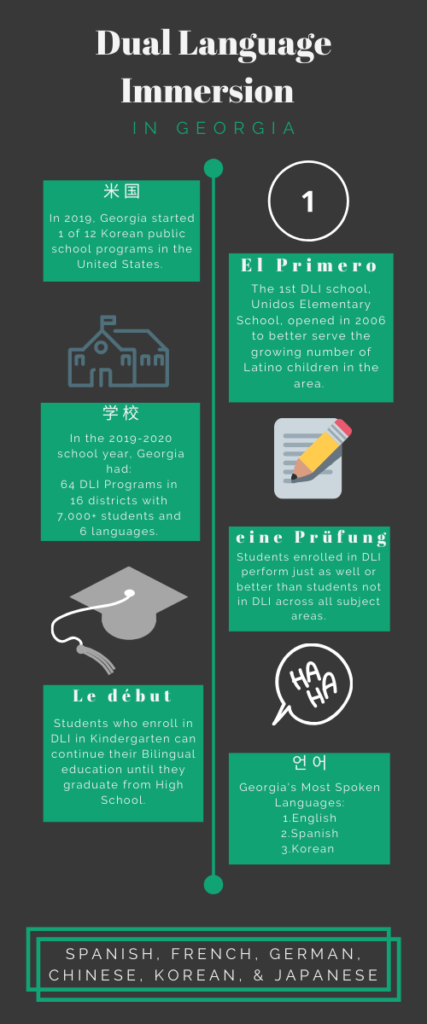Dual Language Immersion (DLI) is a way that bilingual education has been integrated into the public school system beginning in Kindergarten and following through until 12th grade. DLI has gained traction across the country as an effective method of both language acquisition and content learning.

What is Dual Language Immersion?
The 50-50 DLI model means that students receive instruction half of the day in English by one teacher (typically language arts and the social sciences), and then switch classrooms to their target language teacher (usually for math and science classes). Though students will learn in 2 languages, content is at the forefront of it all, and the primary goal of all DLI schools is that students learn their grade-level content. Though content learning might look different than in a traditional classroom, students’ success it not affected by it. DLI students score the same or higher than their non-DLI peers across all subject areas. The rapid growth and the desire from parents & principals to start DLI programs at their schools is a testimony in itself to how effective DLI is.
DLI can take the form of one-way and two-way models.
One-way: Students share a common language background and learn academic content in both that shared language and a new language.
Two-way: Students have varying language backgrounds and learn academic content in English and another language.
Through both models, students will learn the same academic content that their non-DLI peers will learn and develop bilingual proficiency over the course of their K-12 education.
DLI in Atlanta
The program began with Unidos Elementary School in 2006 as a way to meet the needs of a community that was becoming increasingly linguistically diverse. By teaching in both English and Spanish, it allowed the Latino children attending Unidos, who previously struggled with an entirely English-based curriculum, to be placed on the same footing as the rest of the classroom.
For schools around Atlanta who shared similar struggles to Unidos Elementary, DLI became an effective answer for them, too. Its importance in Atlanta ties back to the roots of DLI and how it allows for language to become a connector in the classroom instead of being the dividing factor. By working through this communication struggle together, DLI students develop skills of cooperation in a diverse setting, empathy, and bilingualism – all of which are relevant skills to surviving in the environment that exists beyond their classroom walls today.
Now, there are X schools with Dual Language Immersion programs in Atlanta. These classrooms are global spaces, that are building bridges, creating communities, and transforming our city.

DLI students & teachers
In addition to bilingual skills and an education, students develop an array of personal skills. These skills create well-rounded individuals who are globally competent and are prepared for any career they choose, regardless if the career is globally-focused or not.
DLI teachers play a crucial part in this development. They are first and foremost great teachers – they are educators who desire for their students to learn the academic material and grow personally. They then become trained to become DLI teachers and collaborate with their language teacher counterpart in order to ensure academic success and personal growth in both languages.
DLI Schools
Dual Language Immersion schools don’t just have a program because they think a language would be nice, the language is chosen with intention: to create connections to the community. When deciding upon a language for DLI, schools are expected to find out what their community needs and will benefit the most from. In this way, the language choice is a very intentional decision made together by a school and its community. Though not always the case, DLI schools are often a reflection of the community’s demographics because being able to communicate, collaborate, and better understand neighbors is one of the most meaningful ways that DLI programs can benefit their communities.
One example of this choice to create a Dual Language Immersion program to benefit the community is Parsons Elementary school in Suwanee. This school is one of 12 Korean DLI schools in the country, and the language wasn’t chosen by mistake. Suwanee has a fairly large Korean community, and it’s growing, and now Korean is now being represented in the community through classrooms. Students with Korean heritage are not just connecting to their identity and culture in classrooms, but English speaking students are also learning about that culture through the Korean students and language learning. Through students, schools are connecting to the community and the people in it, and are creating positive changes for these communities.